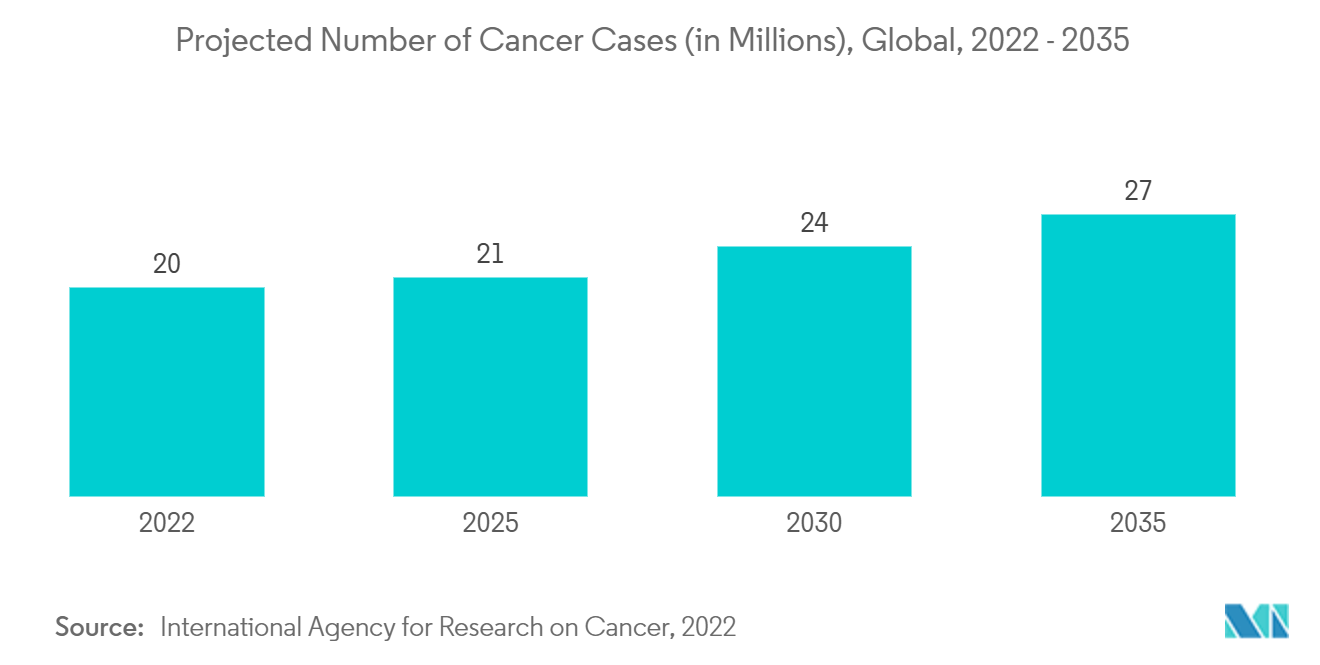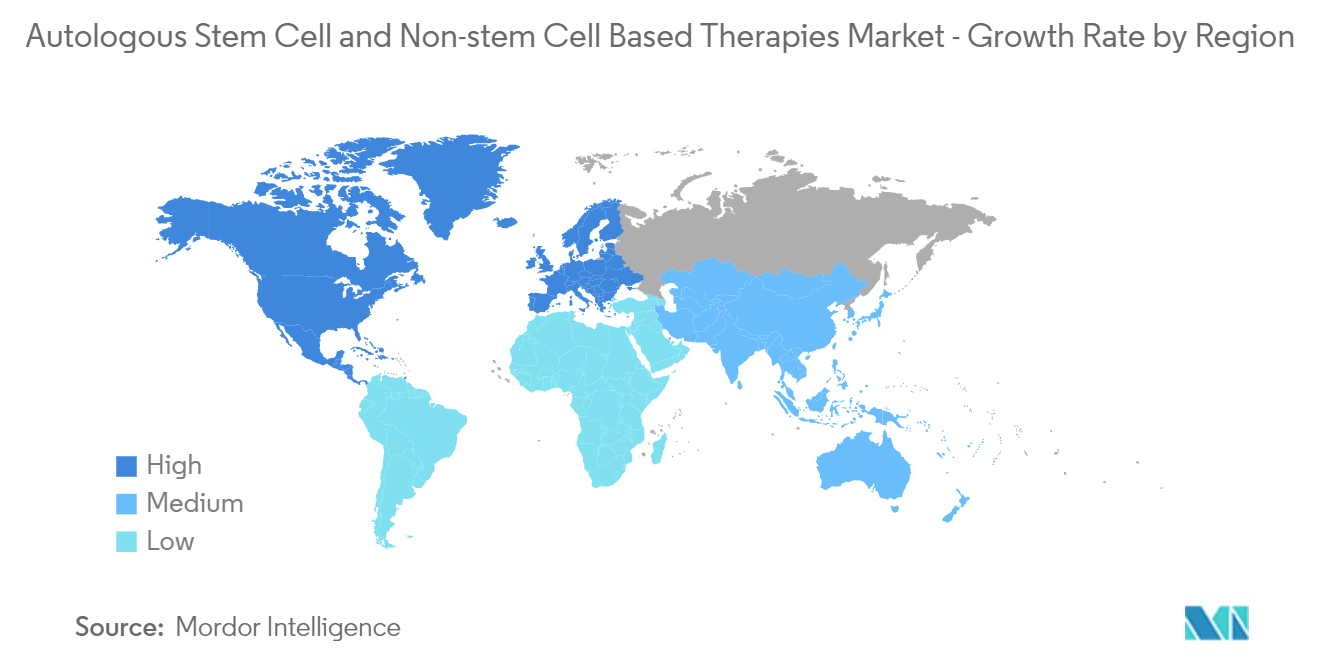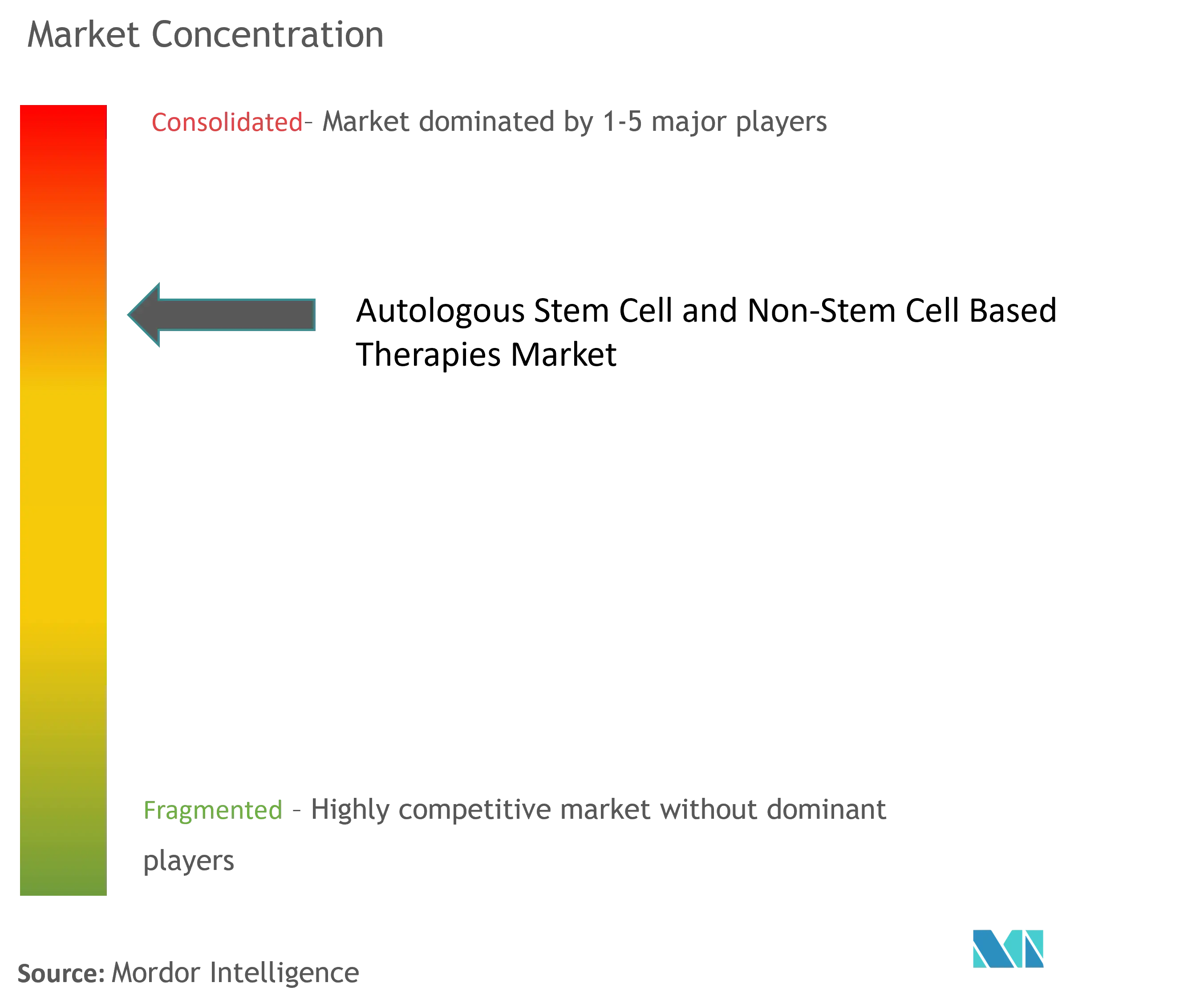
Autologous Stem Cell And Non-Stem Cell Based Therapies Market Analysis
The Autologous Stem Cell And Non-Stem Cell Based Therapies Market size is estimated at USD 6.45 billion in 2025, and is expected to reach USD 12.90 billion by 2030, at a CAGR of 14.89% during the forecast period (2025-2030).
Factors such as the rising prevalence of targeted diseases, the introduction of novel autologous stem cell-based therapies in regenerative medicine, and the increase in the geriatric population are expected to boost the market's growth during the forecast period.
There is a significant increase in the geriatric population around the world, which is vulnerable to being affected with various chronic diseases such as cancer, neurodegenerative disorders, and other diseases and hence fuels the demands for autologous stem cell and non-stem cell-based therapies for treatment. For instance, in July 2023, a report published by the Age United Kingdom Organization reported that there were around 11 million individuals aged above 65 years in England in 2023. This number was projected to increase by 10% and 32% by 2024 and 2043, respectively. Similarly, according to the report published by the United Nations Population Fund in India in September 2023, the population of over 60 in India was expected to increase from 149 million in 2022 to around 347 million by 2050. Further, an article published in the Journal of Cells in November 2022 mentioned that stem-cell-based therapy is significantly used for the treatment of various neurological disorders such as Alzheimer’s disease, Parkinson's disease, multiple sclerosis, and other neurological disorders due to the ability of stem cells to replace damaged cells and tissues coupled with anti-inflammatory and immune-modulatory properties. Thus, the growing geriatric population, coupled with an increase in the occurrence of degenerative diseases, which could be treated with the help of stem cell therapy, is expected to contribute to the market's growth during the forecast period.
Stem cell technology is a speedily developing technology that plays a significant role in regenerative medicine. It also serves the disciplines of tissue engineering, developmental cell biology, cellular therapeutics, gene therapy, chemical biology, and nanotechnology.
Stem cells can replace the cells and tissues to treat various conditions, including spinal cord injury, arthritis, and Parkinson's disease. Therefore, wide applications of stem cells can boost their adoption for treating diseases and are expected to boost the market's growth. For instance, in May 2023, an article published in the International Journal of Molecular Sciences mentioned that mesenchymal stem cells are most commonly used for tissue engineering and implantation to treat arthritis. These cells are effective due to the secretion of bioactive molecules, which induce anti-apoptotic, anti-inflammatory, and immunomodulatory responses that boost the regeneration and stimulation of tissue-specific progenitors. Thus, the increasing applications of stem cells in the treatment of various disorders are expected to contribute to the market's growth during the forecast period.
The new approvals concerning autologous stem cell-based therapies are anticipated to increase the adoption of innovative products and boost the market's growth. For instance, in October 2023, Aspen Neuroscience received approval from the United States Food and Drug Administration for fast-track designation for ANPD001, an autologous investigational cell therapy used to treat Parkinson's disease in improving motor function. Additionally, in September 2023, BioLineRx Ltd received the United States Food and Drug Administration approval for Aphexda (motixafortide) along with filgrastim (G-CSF) to induce mobilization of hematopoietic stem cells to the peripheral blood for collection and subsequent autologous transplantation in patients with multiple myeloma.
The aforementioned factors, such as the increase in the geriatric population and applications of autologous stem cell therapy in chronic diseases like arthritis, coupled with new product approvals, are expected to boost the growth of the market studied during the forecast period. However, the high cost of autologous cellular therapies and the need for more skilled professionals are anticipated to hinder the growth of autologous stem cell and non-stem cell-based therapies during the forecast period.
Autologous Stem Cell And Non-Stem Cell Based Therapies Market Trends
The Cancer Segment is Expected to Hold a Significant Share in the Market
The cancer segment is anticipated to grow significantly in the autologous stem cell and non-stem cell-based therapies market during the forecast period. The growing burden of cancer, coupled with the practical applications of stem cell and non-stem cell-based therapies for cancer treatment and new product launches, are contributing to the growth of the cancer segment.
The rising burden of cancer across the world fuels the demand for effective autologous stem cell and non-stem cell-based therapies. Stem cells are used in cancer treatment because they can self-renew and replace the damaged cells caused by cancer. Thus, the significant use of stem cells to treat cancer is anticipated to contribute to the segment's growth. For instance, in January 2024, according to the American Cancer Society, the prevalence of cancer cases was around 1.9 million in 2023 and is anticipated to reach more than 2 million cancer cases in 2024 in the United States.
Additionally, in February 2024, according to the World Health Organization, about 35 million new cancer cases are expected to be diagnosed by 2050 globally, with an increase of 77% compared to 20 million cancer cases in 2022. Appropriate treatments using patient stem cells and public health action by governments and health practitioners may prevent as many as one-third of cancers worldwide. Hence, with the growing number of cancer patients, the demand for effective stem cell-based therapies is expected to increase, thereby boosting the segment's growth.
Additionally, several studies were conducted to demonstrate the efficacy of autologous stem cell and non-stem cell-based therapies for cancer treatment, thus maximizing the adoption of such therapies by cancer patients. For instance, in December 2023, a study conducted by the American Society of Clinical Oncology mentioned that around 27.8% of patients with large B-cell lymphoma (LBCL) treated with autologous stem cell transplant experienced second relapses compared to the 48% of patients who received CAR-T cell therapy. Thus, the effectiveness of autologous stem cell therapies and non-stem cell-based therapies is expected to be adopted for cancer treatments, driving the segment's growth.
Moreover, the key market players adopting various strategic initiatives to maximize product approvals further contribute to the segment's growth. For instance, in August 2023, Johnson & Johnson received approval from the United States Food and Drug Administration for Talvey (talquetamab-tgvs) for treating adult patients with relapsed or refractory multiple myeloma. Additionally, in February 2022, Johnson & Johnson announced the United States Food and Drug Administration approval for cell therapy Carvyktii (ciltacabtagene autoleucel; cilia-cel) for the treatment of patients with relapsed or refractory multiple myeloma.
Therefore, factors such as the increasing prevalence of cancer, rising clinical research studies, and new product approvals are anticipated to propel the segment's growth during the forecast period.

North America is Expected to Witness a Significant Growth in the Market
North America is anticipated to contribute a significant market share in autologous stem cell and non-stem cell-based therapies. Factors such as the increasing burden of chronic diseases and increasing clinical research programs are expected to boost the market's growth in the region during the forecast period.
The rising number of chronic diseases, such as cancer, diabetes, orthopedic disorders, and chronic kidney diseases, in North America fuels the demand for autologous stem cell and non-stem cell-based therapies, contributing to the market's growth. For instance, according to the data published by the Canadian Cancer Society in November 2023, around 239,100 Canadians were diagnosed with cancer during 2023, and 45% of the individuals in Canada are expected to be diagnosed with cancer in their lifetime.
Similarly, according to the data published by the Global Cancer Observatory (GLOBOCON) in February 2024, around 207 thousand cancer cases were diagnosed in Mexico in 2022 and are expected to reach 255 thousand by 2030. The high prevalence of cancer in the region indicates a sizeable potential demand for stem cell therapies in the market.
Moreover, in November 2023, the American Diabetes Association mentioned that every year, around 1.2 million new diabetic patients are diagnosed in the United States. Additionally, in May 2023, according to the Centers for Disease Control and Prevention, about 35.5 million adults in the United States were reported to have chronic kidney disease in 2023, representing 14% of the adults in the United States. With the rising burden of chronic diseases, the demand for autologous stem cell-based therapies is expected to increase owing to their high proliferation and differentiation capacities, paracrine activity, and immunologic privilege.
The recent programs for developing novel technologies based on autologous stem cell therapies are further expected to drive the market's growth in the region. For instance, in May 2023, University Health Network (UHN) research teams in Canada received USD 1.65 million in funding from the Stem Cell Network (SCN) to advance regenerative medicine therapies. This funding supports stem cell regenerative medical research and clinical trials across 24 projects and 14 disease areas.
Additionally, in August 2022, the National Institute of Health (NIH) reported that the surgical teams implanted a patch of tissue made from patient cells, i.e., autologous stem cell therapy, for the treatment of “dry” age-related macular degeneration (AMD).
Thus, the market studied is anticipated to grow in North America due to factors such as the growing burden of chronic diseases, research and development activities coupled with rising funding initiatives, and the adoption of autologous stem cell therapies in hospitals.

Autologous Stem Cell and Non-stem Cell Based Therapies Industry Overview
The global autologous stem cell and non-stem cell-based therapies market is consolidated and dominated by a few major players. The primary focus is to improve research and development with strategic initiatives such as mergers and acquisitions and to establish advanced technological tools to enhance the development of products. Some of the key players in the market are Novartis AG, BrainStorm Cell Limited, Caladrius, Cytori Therapeutics Inc., Dendreon Pharmaceuticals LLC, US Stem Cell Inc., Gilead Sciences Inc., and Regeneus Ltd.
Autologous Stem Cell and Non-stem Cell Based Therapies Market Leaders
-
BrainStorm Cell Limited.
-
Cytori Therapeutics Inc.
-
Dendreon Pharmaceuticals LLC
-
Novartis AG
-
U.S. Stem Cell, Inc.
- *Disclaimer: Major Players sorted in no particular order
Autologous Stem Cell and Non-stem Cell Based Therapies Market News
- April 2024: Vertex and TreeFrog Therapeutics collaborated, which involves the development of a stem cell-derived, fully differentiated islet cell VX-880 Ph 1/2 program, which can be used to treat type-1 diabetes.
- January 2024: Stemcell Technologies acquired Propagenix Inc. to develop technologies for facilitating new approaches in regenerative medicine. Through the acquisition, the advanced technology of Propagenix is likely to promote scientific research in laboratories and clinical facilities in the applications of cancer, respiratory disorders, and other disorders.
Autologous Stem Cell And Non-Stem Cell Based Therapies Industry Segmentation
As per the scope of the report, autologous stem cell therapy or stem cell transplant uses healthy blood stem cells from one's own body to replace diseased or damaged bone marrow. Non-stem cell-based therapy comprising autologous platelet-rich plasma (PRP) is a treatment that contains fibrin and high concentrations of growth factors and has the potential to improve the healing of chronic wounds.
The market is segmented by type, application, end user, and geography. By type, the market is segmented into autologous stem cells and autologous non-stem cells. By application, the market is segmented into cancer, neurodegenerative disorders, cardiovascular disease, orthopedic diseases, and other applications. By end user, the market is segmented into hospitals, ambulatory surgical centers, and research facilities. By geography, the market is segmented into North America, Europe, Asia-Pacific, Middle East and Africa, and South America. The market report also covers the estimated market sizes and trends for 17 different countries across major regions globally. The market provides the value (USD) for the above-mentioned segments.
| By Type | Autologous Stem Cells | ||
| Autologous Non-Stem cells | |||
| By Application | Cancer | ||
| Neurodegenerative Disorders | |||
| Cardiovascular Disease | |||
| Orthopedic Diseases | |||
| Other Applications | |||
| By End User | Hospitals | ||
| Ambulatory Surgical Centers | |||
| Research Facilities | |||
| Geography | North America | United States | |
| Canada | |||
| Mexico | |||
| Europe | Germany | ||
| United Kingdom | |||
| France | |||
| Italy | |||
| Spain | |||
| Rest of Europe | |||
| Asia-Pacific | China | ||
| Japan | |||
| India | |||
| Australia | |||
| South Korea | |||
| Rest of Asia-Pacific | |||
| Middle East and Africa | GCC | ||
| South Africa | |||
| Rest of Middle East and Africa | |||
| South America | Brazil | ||
| Argentina | |||
| Rest of South America | |||
Autologous Stem Cell & Non Stem Cell Based Therapies Market Research FAQs
How big is the Autologous Stem Cell And Non-Stem Cell Based Therapies Market?
The Autologous Stem Cell And Non-Stem Cell Based Therapies Market size is expected to reach USD 6.45 billion in 2025 and grow at a CAGR of 14.89% to reach USD 12.90 billion by 2030.
What is the current Autologous Stem Cell And Non-Stem Cell Based Therapies Market size?
In 2025, the Autologous Stem Cell And Non-Stem Cell Based Therapies Market size is expected to reach USD 6.45 billion.
Who are the key players in Autologous Stem Cell And Non-Stem Cell Based Therapies Market?
BrainStorm Cell Limited., Cytori Therapeutics Inc., Dendreon Pharmaceuticals LLC, Novartis AG and U.S. Stem Cell, Inc. are the major companies operating in the Autologous Stem Cell And Non-Stem Cell Based Therapies Market.
Which is the fastest growing region in Autologous Stem Cell And Non-Stem Cell Based Therapies Market?
Asia Pacific is estimated to grow at the highest CAGR over the forecast period (2025-2030).
Which region has the biggest share in Autologous Stem Cell And Non-Stem Cell Based Therapies Market?
In 2025, the North America accounts for the largest market share in Autologous Stem Cell And Non-Stem Cell Based Therapies Market.
What years does this Autologous Stem Cell And Non-Stem Cell Based Therapies Market cover, and what was the market size in 2024?
In 2024, the Autologous Stem Cell And Non-Stem Cell Based Therapies Market size was estimated at USD 5.49 billion. The report covers the Autologous Stem Cell And Non-Stem Cell Based Therapies Market historical market size for years: 2021, 2022, 2023 and 2024. The report also forecasts the Autologous Stem Cell And Non-Stem Cell Based Therapies Market size for years: 2025, 2026, 2027, 2028, 2029 and 2030.
Our Best Selling Reports
Autologous Stem Cell and Non-Stem Cell Based Therapies Industry Report
Statistics for the 2025 Autologous Stem Cell And Non-Stem Cell Based Therapies market share, size and revenue growth rate, created by Mordor Intelligence™ Industry Reports. Autologous Stem Cell And Non-Stem Cell Based Therapies analysis includes a market forecast outlook for 2025 to 2030 and historical overview. Get a sample of this industry analysis as a free report PDF download.




